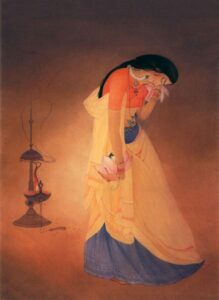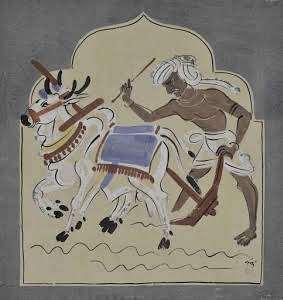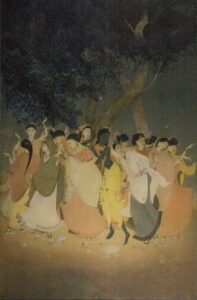
Shiva and Sati
Subject Matter – Shiva and Sati, a mythological and spiritual theme, depicts the Hindu god Shiva and his consort Sati in a moment of divine union and cosmic harmony.
Artist – Nandalal Bose, a prominent artist associated with the Bengal School.
Technique – Nandalal Bose used the traditional Bengal School technique characterized by intricate detailing and vivid colours. In this painting, he employed the flattened perspective often found in miniature painting, which allowed him to focus on the symbolic elements of the scene. The figures of Shiva and Sati would have been rendered with fine lines and exquisite details, set against a lush, intricate background featuring motifs and symbols associated with Hindu mythology.

Description –
Shiva And Sati is a beautiful wash painting of Nand Lal Bose. It’s one of the series of his wash painting based on Shiva mythology. He transformed religious prototype venerated form of lord Shiva to a simple person of eternal youth who gives lesson to everyone.
From his work and behavior, his Shiva in a new look, infect represents Shiva – tattva, the essence of Shaivism on a new spiritual platform. In this painting we feel eternal peace and sorrow is spread everywhere because Sati’s body is shown in the lap of Shiva. In spite of that, the face of Shiva is shown in deep meditation. there is a hallow shown around the head of Shiva. He looks a placid mood.
There is no sign of agitation on his face. it reflects the height of spiritualism which convey s that the worst situation of life should be crossed with placid meditative mood and natural emotion. though the flat colours are used in this painting but the plasticity of Sati’s body is shown by drawing.
The outline of the whole composition is smooth, rhythmic and sharp. the soft and monochromatic effect of the mixture of white, yellow ochre, orange, brown and black is nice. in the guise of this mythic theme Nand Lal gives a massage of transcendental truth to modern human life. Now, it is a collection of national gallery of modern art, new Delhi.
Human Values – @ love, care, for his wife (sati)
Journey's End
Subject Matter – “Journey’s End” is a painting that captures a serene, idyllic landscape with a river or stream winding its way through a picturesque countryside. It reflects Abanindranath Tagore’s interest in depicting the beauty of nature.
Artist – Abanindranath Tagore, one of the leading figures of the Bengal School.
Technique – Abanindranath Tagore often incorporated the Japanese wash technique, which he learned from Okakura Kakuzo, in his works. This technique involves using delicate, translucent washes of color to create a dreamlike and ethereal atmosphere. In “Journey’s End,” he likely used this technique to create soft, flowing lines and subtle color transitions in the landscape. The composition would have emphasized harmony with nature and the tranquility of the scene

Description – The painting journey’s end done by Abnindra Nath Tagore is a very meaningful painting. A loaded camel is about to fall and die on a stony ground. He is very exhausted after a long journey. It seems that the camel has worked more than his capacity. The effect of sunset been shown in the painting through red, brown and yellowish orange color. A desert has been depicting gracefully.
The whole composition is well balanced, rhythmic and harmonized but there is some point which compel us the criticize the compositional arrangements of this painting based on the aesthetical parameters as it is a symbolic painting and there is no presence of any compositional elements such as a hut or sand mountains (being a desert) etc. on the whole this composition provides a mystical effect i.e. some kind of clarity is required.
Human Values – @ Do not be inhuman and cowardliness animal @ loyalty to the master @ Teaches the need that the master should be caring and responsible for his dependent’s well being
.
Radhika
Subject Matter – “Radhika” likely depicts Radha, a central figure in Hindu mythology and the beloved of Lord Krishna. The subject is a celebration of love and devotion.
Artist – A. R. Chughtai, who was not directly associated with the Bengal School but was influenced by its techniques and themes.
Technique – Chughtai’s style incorporated elements of the Bengal School, including intricate detailing and vibrant colors. In “Radhika,” he would have focused on rendering Radha with grace and sensitivity, using fine lines and delicate brushwork. The composition might have featured Radha in a contemplative or expressive pose, surrounded by lush natural elements and symbolic motifs associated with the Radha-Krishna legend.

Description –
Radhika Is one of the best wash painting of M.A.R.Chughtai . In this painting, a very delicate Indian Lady is shown coming out of her room. Her face is profile, head is down and eyes are in graceful look with sharp eyebrows. Her left foot is in forward motion. She is holding lotus flower in her both hands. Her left hand is shown near face while right hand is hanging down in a typical posture. A honeybee is shown sitting on the flower.
She is wearing light purple duptta ,red blouse and yellow odhani. Her hair is painted in black and brown combination and reaches up to her back. She is wearing well finished pearl necklace with pendent and thread necklace along with a beautiful pendent. She has bangles in her hands and rings in fingers. in background a lamp along with lampshade is shown with burning flame and smoke. The background is made beautifully by the fusion of red, yellow and black colors.
The whole composition is giving a beautiful impression due to its rhythmic form and flexibility. Now it is a collection of National galleries of modern art New Delhi.
Human Values – @ love and commitment
Meghdoot
Subject Matter – “Meghdoot” refers to the famous Sanskrit poem “Meghadūta” by Kalidasa, which describes a Yaksha (a celestial being) sending a message to his beloved through a cloud messenger.
Artist – Ram Gopal Vijayvargeeya, the artist associated with this particular work.
Technique – In a painting inspired by “Meghadūta,” the artist would have used the Bengal School’s traditional technique, combining intricate detailing and vibrant colors. The composition might depict the celestial landscape and the Yaksha’s emotional state as he communicates with the cloud messenger. The use of symbolism and delicate brushwork would capture the essence of the poetic narrative.

Description – The painting Meghdoot painted by the Artist Ramgopal Vijayvargiya during 1961-66A.D.was done in watercolor, tempera medium in watercolor ‘wash technique’. Meghdoot in three separate series-based om famous Sanskrit classic ABHIYAN SHAKUNTALAM written by Kali das. Each series consists of 60 to 70 paintings.
In this painting the could messenger Meghdoot is shown taking yaksha’s massage to his concert during rainy season. This painting has obvious effect of Bengal school style mixed with typical Ajanta characteristics. The drawing reflects calligraphic freedom and maintains the essence of form. the yksha’s is shown sitting in knee down posture having profile face, softly smiling face fluttering hair and doe like eyes. He has some wild flowers in his long and thin left hand. He has tapering artistic fingers and long legs.
He is shown indulged in writing a love letter in the midst of vibrant forest site in the lap of nature. The nature is shown in a happy and blissful mood. He is shown wearing traditional dhoti and having a long veil on his left shoulder. There is a flower garland around his neck and a traditional closed thread called ‘janeu’ on his right shoulder. The cloud full of rain water are shown floating very closed to yaksha as if they were eager and exited to take massage from yksha and send to his consort.
Here clouds are depicting in a very special manner, which looks natural and attractive. The birds are shown flying higher than clouds. Now, it is a collection of National Art Gallery of Modern Art New Delhi.
Human Values – @ Love, commitment and faithfulness.
Tiller of Soil
Subject Matter – “Tiller of Soil” is likely a depiction of a rural scene with a farmer tilling the land, symbolizing the connection between humanity and the earth.
Artist – Nandalal Bose, a prominent artist associated with the Bengal School.
Technique – Nandalal Bose would have employed the Bengal School’s traditional techniques in this painting. He would have focused on detailing the farmer’s figure and the tools used in tilling, highlighting the dignity of labour. The background might have included elements of the rural landscape, showcasing the beauty of the Indian countryside. This composition would convey a deep appreciation for rural life and the importance of agriculture in Indian culture.

Description – The tiller of the soil is one of the 83 Haripura posters made by Nandlal Bose in 1937.Thr themes of these decorative posters were related to the religious episodes of Indian culture scenes of daily life musician, athlete, cobbler, farmer, village, crafts, nymphs, animals and other decorative motifs.
He applied the techniques borrowed from KALIGHAT PAT PAINTING and rich folk art and craft traditions of India. In this poster tiller of soil, a farmer is shown indulged in ploughing his field he is half-naked and shown wearing a folded dhoti and turban on his head. He is also holding a stick in his right hand. His oxen are well decorated with clothes and ornaments. Here just three curvilinear lines show plough field skillfully. The lines used in this work are very forceful and effective.
The drawing of his oxen, dress of farmer, and his body all bear a lyrical harmonious rhythm. The whole composition has been made very fast with tempera colors on paper then pasted on a hard board. These posters are very economically and represent Indian life and culture. Now it is a collection of National Gallery of Modern Art New Delhi.
Human Values – @ Dignity of labour @ Respect for farmer as a provider of food @ Respect for mother earth and sustainability
Ras Lila
Subject Matter – “Ras Lila” typically portrays the divine dance of Lord Krishna with the gopis (milkmaids) in Vrindavan, a popular theme in Indian art and literature symbolizing divine love and union.
Artist – The artist’s full name is not provided, but it’s attributed to Majumdaar.
Technique – The Bengal School technique would have been employed in this painting. The artist would have used intricate detailing and vivid colours to depict the figures of Krishna and the gopis dancing in a circle, conveying a sense of joyful movement and divine ecstasy. The background may include elements of the natural landscape and architectural details.

Description – The painting Ras Leela has been painted is a vertical asymmetric figurative and well-integrated wash painting by KHSITINDRA NATH MAJUMDAR in 1926 the size of the painting 14.3X9.4 cm. on the basis of aesthetical parameters, this painting has all the reasons for which we can accept that its painter been successful in depicting the subject matter.
In the painting Krishna is shown dancing along with eleven Gopi’s under the vibrant trees in moon light. Here we find that the main theme is painted frontally against a simple background. The background is full of rugged tree trunks laden with softly repeated drooping leaves patterns. Krishna and Gopi’s are shown in special type of soft, gentle, poetic and rhythmic body gestures. They have very delicate look.
They are tall having oval shaped head and flower like hands. The posture of Krishna is tall attenuated and looks effeminate. His hair is piled. There is halo around his head to mark his divine virtues. He is decorating with various types of ornaments. Krishna is half naked and dressed in dhoti. Gopi’s are painted in lehenga and dupatta. The hair style of Gopi’s is either piled or having charming plait. Their cascading soft draperies mark the dancing rhythm. Their face expression is full of divine pleasure. Here the act of dancing and singing is painted nicely and artistically.
The theme of Raslila is taken from Bhagavat Purana in which Krishna and Gopi’s dance called Maharas and symbolically indicates the dance of God and soul. Really, it’s a very beautiful and attractive wash miniature. Now it is a collection of National Gallery of Modern Art, New Delhi.
Human Values – @ Love and commitment @ Love, devotion and faith in the divine @ Self forgetfulness to be one with the supreme @ Enjoyment in ultimate spirituality